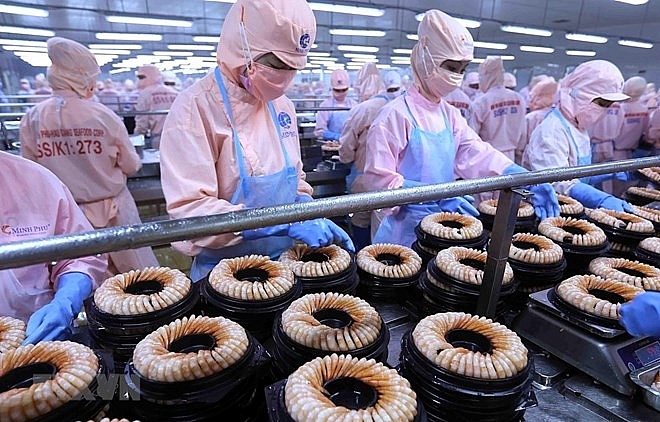WB highlights benefits, challenges from FTA with EU to Vietnam
 |
| A frozen shrimp processing line at Minh Phu Hau Giang Seafood JSC - the Minh Phu Seafood Group at Song Hau industrial park, Chau Thanh district, Hau Giang province. (Photo: VNA) |
In an interview with the Vietnamese News Agency (VNA), the economist said the EVFTA is an important trade deal after the Comprehensive and Progressive Agreement for Trans-Pacific Partnership (CPTPP) that Vietnam ratified late last year and became effective early this year.
“EVFTA is another big important FTA because of the size of the market,” he said, adding the EU is the second largest export market of Vietnam.
According to the economist, Vietnam and Singapore are two ASEAN economies that have such a deep and comprehensive trade agreement with the EU, and the advantage will offer benefits to Vietnam in such areas as food processing and agriculture.
Regarding Vietnam’s economic situation, Eckardt said coming up exceptionally strong growth in 2018, the WB sees that there are some signs that economic activities have been moderating since the beginning of the year.
There are two main reasons. First, global growth has slowed down that has affected external demand, especially for manufacturing, export-oriented manufacturing, which is a big and glowing part of the Vietnam economy. Second, there are some domestic factors, including the impact of the African swine fever on agriculture production, according to him.
Vietnam’s economic growth remains robust in this year despite some difficulties, he said, adding the WB has not changed the outlooks for this year and expects the growth to be 6.6 percent, down from 7.1 percent.
He highlighted manufacturing as the driving force of Vietnam’s economic growth with an average increase of 11 - 12 percent in the last four years.
The sector is driven by the increase in foreign direct investment, thanks to free trade agreements that has signed, according to Eckardt.
He also emphasised the potential of service and agriculture, suggesting Vietnam increase the farm produce value by focusing on processing to create a long-term higher value chain.
What the stars mean:
★ Poor ★ ★ Promising ★★★ Good ★★★★ Very good ★★★★★ Exceptional
Themes: EVFTA & EVIPA
Related Contents
Latest News
More News
- Main drivers for Vietnam’s digital economy future (December 03, 2025 | 11:35)
- Pivotal stage of growth paves way for rise in M&As (December 03, 2025 | 10:00)
- Positive projections for M&A interest from Thailand (December 03, 2025 | 09:40)
- Manifesting the first line of defence in cybersecurity (December 03, 2025 | 09:00)
- The transformational role AI can play in accounting arena (December 03, 2025 | 08:00)
- Unlocking 5G-AI potential in Singapore (December 03, 2025 | 08:00)
- Data-driven strategies vital for a fast-evolving nation (December 02, 2025 | 09:41)
- Policy to practice: how Vietnam can lead the region (November 26, 2025 | 16:03)
- Mobilising private capital at scale vital for climate battle (November 26, 2025 | 15:36)
- VILAF and Yoon & Yang launch Vietnam - Korea Practice Unit (November 26, 2025 | 15:16)

 Tag:
Tag:





















 Mobile Version
Mobile Version